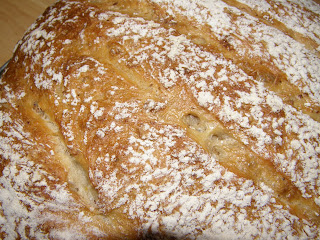I began making the bread using a poolish that was in the refrigerator for a week or so. This poolish is 50/50 flour and water by weight with 1/4 tsp of yeast. It rests on the counter until it has doubled, then is placed in the refrigerator until needed. When I took it out, it had a nice tang and was ready to use.
I began to build the bread using the standard ratio for a 65% loaf and calculated the amount of flour and water to use for about two 2 pound loaves.
 Here is my calculation:
Here is my calculation:2 loaves @ 900 grams each = 1800 grams total for flour and water (ignore the salt and yeast).
I weighed the poolish and got 510 grams, so that is 255 grams of flour and 255 grams of water.
The total amount of flour I want is 1800 x 0.65 - 1170 grams of flour, and
The total amount of water is the remainder or 1800 - 1170 = 630 grams of water.
But I already have some the the amounts I need to add are 1170 - 255 = 915 grams of flour and 630 - 255 = 375 grams of water.
I calculated 1% yeast as 1800 grams total x 0.01 = 18 grams of yeast. I measured it out into a small dish and did the same with the salt at 18 grams. (Oops!)
I mixed the poolish with warm water and added the yeast and began adding flour. Then I added dry milk, one whole packet, enough for a quart of milk. My thinking is that the milk will give a more tender loaf. I also added 1 Tbs of honey. I put the dough in the mixer with the dough hook and continued to add flour until the consistency was about right. It did not take all the flour.
I put the dough on the floured board and kneaded and stretched it, then covered it with a large bowl and set my time for 40 minutes.
When I came back the dough had lifted the bowl off the board and it was growing like mad! It was huge! I knocked it down and pulled and stretched it again. I looked at it and said it is done and cut it in two and shaped it and put it into two bread pans and covered it lightly with plastic wrap. I turned the oven on to 400 F. It took 20 minutes to heat the oven and when the bell rang that it was hot, the dough was a inch above the pan rims.
I seeded the loaves with flax seed and cut the tops about 3/4 inch deep. They sprang open. They went into the oven with steam and bloomed like you see in the picture.
What happened? I clearly used too much yeast. The calculation should be on the flour, not the total and instead of 18 grams, it should be 12 grams.
The bread was done in 30 minutes.
The bread was good and did not have too much salt. It toasted nicely and was somewhat too tender. Next time I will use the right amount of yeast and half as much milk powder.










